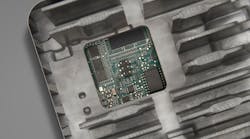GM Taps Qualcomm Chips For Self-Driving System Due Out in 2023
Check out our CES 2022 coverage.
At this month's Consumer Electronics Show, GM said that it will use a cluster of three chips developed by Qualcomm as the brains of the Ultra Cruise automated driving system in new vehicles due out in 2023.
GM said Ultra Cruise will be able to handle 95% of all driving scenarios and eventually be used on every paved road and highway in the U.S. and Canada. The system builds on GM's advanced driver assistance system called Super Cruise, first introduced to cars in 2017 but that only operates on U.S. highways. GM plans to include Ultra Cruise in several upcoming cars, including its all-electric Cadillac Celestic sedan.
The announcement comes as Qualcomm, long the world's largest player in modems and other chips for mobile phones, continues its efforts to better engage with the auto sector. It has been striking deals with auto giants to supply chips to run digital dashboards and connect vehicles to the cloud over 5G networks.
But GM is the first car manufacturer to adopt Qualcomm's "Snapdragon Ride" chips for its self-driving gear.
At CES, Qualcomm said it landed deals to supply its "Snapdragon Cockpit" chips to Volvo and Honda to run the digital dashboards in their cars. The companies said the chips can be upgraded wirelessly in the future.
Qualcomm Inside
At the heart of the Ultra Cruise system is a computer module about the size of two laptops stacked together. It will be powered by a scalable compute architecture using Qualcomm chips and GM's proprietary software stack. The software will handle chores such as pinpointing the car's location ("localization) to using sensors to chart the car's surroundings ("perception"), to planning out the car's route on the road ahead ("planning").
Under the hood are a pair of the same high-end processor, known as SA8540P, which integrates 16 central processing cores, and a separate artificial intelligence (AI) accelerator called the SA9000P. Based on the 5-nm node, the chips pump out more than 300 trillion operations per second to plot out the world around the vehicle—with cameras, radar, and lidar sensors acting as the eyes—and then react to obstacles in real-time.
High-speed sensor interfaces and memory bandwidth supplement the chips. To meet safety requirements in cars, the Snapdragon Ride chips are paired with a safety-focused Aurix microcontroller (MCU) from Infineon. The Aurix chip is rated as ASIL-D–the highest safety integrity standard in vehicles. Packaging all these chips together helps add redundancy to the system, protecting against failures that can endanger the driver.
"Despite its relatively small size, Ultra Cruise's compute will have the processing capability of several hundred personal computers," said Ken Morris, GM's vice president of electric and autonomous car programs.
GM said Ultra Cruise uses a combination of cameras, radars, and lidar sensors to create accurate, real-time 360-degree views of other vehicles and obstacles in the car's surroundings. GM's new system will be able to completely take control of the vehicles—from making left- and right-hand turns and changing lanes to passing other cars on the highway ahead while remaining under the speed limit and reacting to traffic lights.
The driver can take their hands off the wheel while the vehicle is in semi-autonomous driving mode. But GM said Ultra Cruise requires them to pay attention at all times and take the wheel when the system is stumped.
Auto Ambitions
Qualcomm has rolled out a suite of cloud-connected automotive platforms, ranging from the brains of future self-driving cars to chips that control digital dashboards in cars, which auto firms can buy à la carte or in full. It is also integrating its chips with software from Arriver, which was part of its $4.5 billion deal for automotive technology giant Veoneer last year and assists safety features such as automated lane control.
Qualcomm is wrestling with NVIDIA and Intel's Mobileye as well as automotive chip giants such as NXP to win market share in chips that control self-driving systems in cars. It introduced Snapdragon Ride in 2020.
At CES, Mobileye announced its EyeQ Ultra processor purpose-built for Level 4 autonomous driving. The company said the chip is based on a 5-nm node and pumps out up to 176 trillion operations per second, matching the performance of 10 of its current EyeQ 5 chips put together. Mobileye said it plans to start manufacturing the new Ultra chips by 2023, with mass production for the automotive sector by 2025.
One of the key requirements for these chips in electric vehicles is power efficiency. Slashing the power of the self-driving systems in electric cars is critical since they have to share limited battery life with the powertrain.
Qualcomm is trying to take advantage of its vast expertise in the smartphone chip business to build chips that burn through less power and generate less heat than other solutions on the market. GM said the Ultra Cruise system is passively cooled, meaning it will not require heavy and inefficient cooling lines throughout the vehicle. GM said this is possible thanks to Snapdragon Ride's high-performance, power-sipping design.
GM would not say how much power the Ultra Cruise system consumes, but the fact it is air-cooled means the chips likely use less power than processors that require water or other coolants to prevent overheating.
GM said Ultra Cruise will have the ability to evolve over time, tapping Snapdragon Ride's performance and high-speed interfaces for future expansion. The system will also be able to get wireless software updates.

